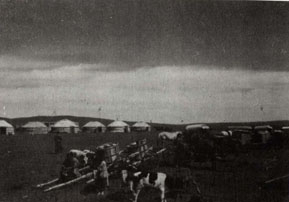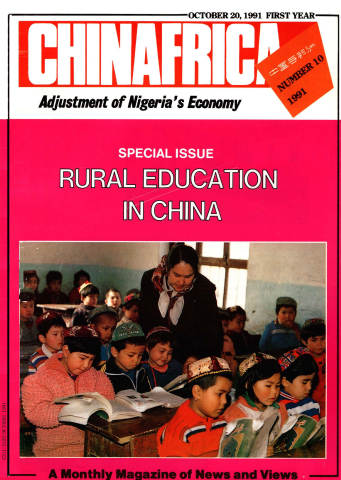The Mongolians are a nomadic people that live on the banks of the Xini River on the Hulun Buir grasslands in northern China. Today most of them have settled down to a sedentary life.
Because the Mongolians are so used to roaming around in search of new grazing pasture-land, most of them prefer to live in the traditional Mongolian felt yurt similar to a round tent. These are the typical dwellings for north China’s nomads. Usually made of willow branches and wooden planks, they are convenient, easy to the pitch and protect against the wind and the cold. The Mongolians in other parts of China, the Ewenki and Daur in the northeast, the Kazak and Tajik in the northwest, use similar felt yurts. They are different in height and shape, and in name, but the general structure is the same. Folk culture and traditions among the Mongolians in different places are also very similar.
In early winter last year, when I arrived on the grassland along the Weitegen River, I happened to see herdsmen building a yurt for newly-weds. I was told that men of noble character and high prestige all took part in this activity. I suddenly understood that it was a very solemn ceremony to build a yurt. The elderlies were tying first two-metre-long wooden rods together with woollen ropes into a circular wall. The bridegroom’s father was in charge of this ceremony. He stood in the centre, holding up the top ring of the yurt with both hands as if receiving the radiant rays of the sun (the Mongolian and other nomad nationalities in the north worship the sun, moon, heaven, earth and fire); those who came to help connected a few dozen brightly painted poles around the top ring forming an umbrella-like framework. Then the bridegroom’s father freed his hand and ceremoniously brought in an iron stove. According to local custom, in this way he had invited the “fire” into the new abode. This meant that from then on the new occupants would be protected by the goddess of fire and will be prosperous and have sons.
On the Fangcai pasture, one moment it was cloudless and fine, the next, it snowed, but despite all this everyone went on without stopping. They wanted to fix up the yurt before the bride arrived. Soon, one, and then another layer of thick and strong felt covered the yurt’s framework. A handmade “good luck” pattern was done in hazel-coloured woollen thread onto the felt. They tied coloured silk ribbons from the structure and tail ends of the woollen ropes like bunting. When the woollen ropes on the felt were securely in place, a new Mongolian yurt was complete.
Next the bridegroom’s father was busy getting wine to worship the heaven and the earth. At this moment the helpers took a rest and were invited into an old yurt to drink milk tea. While the men had been conscientiously erecting the yurt, the women were busy preparing for the wedding banquet in the host’s old yurt. These weather-beaten old yurts are still strong, warm and cozy and life went on as usual. Once grown up, sons and daughters leave home and make their own home elsewhere on the grasslands.
When the new yurt was ready, people began coming in. Taking directions from a few old elderly women, everyone started arranging the fixtures. According to custom, the fire is placed in the centre. Opposite the entrance is a long, low table; main furniture such as clothes trunks are put on the right side and felt, cowhide and sheepskin laid around the yurt. A large area of grass was kept around the fire. According to custom, the head of the family and guests should sit opposite the entrance and on the left side; on the right side of the entrance was a beautiful brass bed covered with new blankets, this was obviously the new couple's special corner.
From a neighbouring old yurt I could smell whiffs of savoury meat. When I went outside I saw neighbours in their holiday best riding horses or approaching on foot to attend the grand wedding banquet.
The women of the bridegroom's family were now gathered in front of a row of large iron trunks at the rear of the yurt. They were preparing the wedding attire for the bridegroom and gifts for guests. Mongolian people keep most of their belongings in these iron trunks. I have seen many people who live in brick houses still use such large iron trunks.
At dusk, the bride and her relatives arrived and rode around the bridegroom’s home three times before entering the new yurt. Because it was winter, the wedding party had to be held in the yurt instead of in the open. People sat according to family status, ate, drank, and thoroughly enjoyed themselves. To participate in the ceremony was the best opportunity for boys and girls to get to know each other. It is said that the present couple became aquainted at someone else's wedding. The bridegroom and bride sat in their new, warm yurt, listening to the sad farewell songs sung by the bride’s brothers and sisters, but with a smile of happiness on their face.
IN BRIEF
Chinese Cultural Sites On World Heritage List
Five of the most famous cultural sites of ancient China were named World Heritage by the UNESCO.
Added to the list were the Forbidden City, the Great Wall, the site of the Zhoukoudian (where the sinanthropus “Man of Beijing” lived), the Tomb of the first Qin Emperor, and the grottoes of Dunhuang.
By the end of 1990, some 337 cultural sites in the world were put on the World Heritage list established by the UNESCO.
Erratum
In our last issue No. 9, the captions to our photos on P.4 and P.5 were reversed. Our apologies for any inconvenience caused.

Mongolian yurts. YANG GONG



 Copy Reference
Copy Reference 